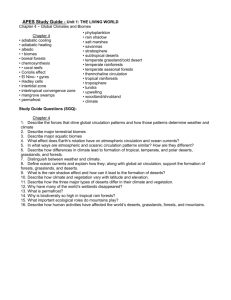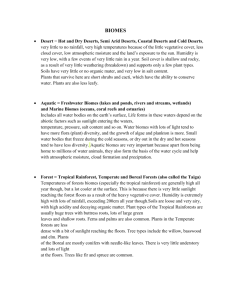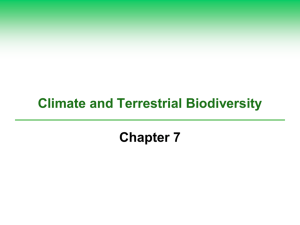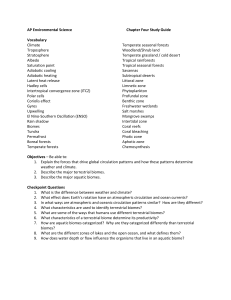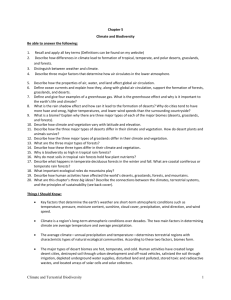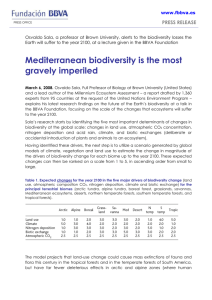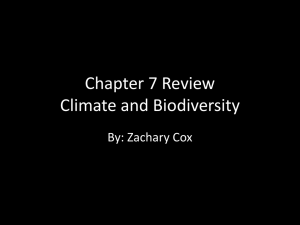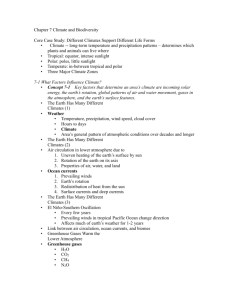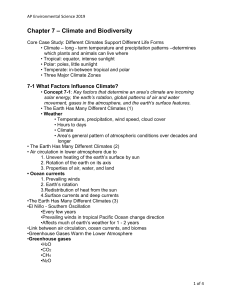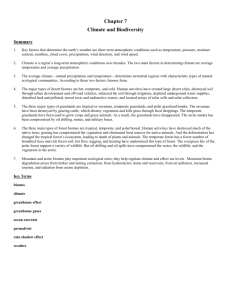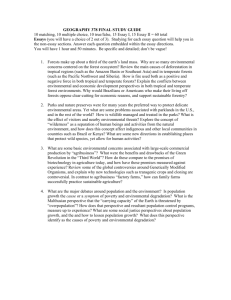Climate and Terrestrial Biodiversity
advertisement
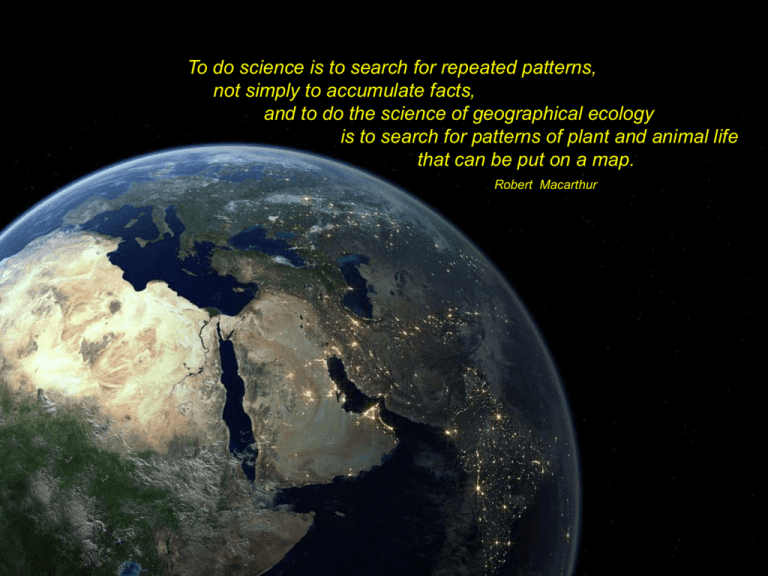
To do science is to search for repeated patterns, not simply to accumulate facts, and to do the science of geographical ecology is to search for patterns of plant and animal life that can be put on a map. Robert Macarthur Climate and Terrestrial Biodiversity Chapter 7 Core Case Study: Connections between Wind, Climate, and Biomes • Wind – Indirect form of solar energy • Circulates – Heat – Moisture – Plant nutrients – Soil particles – Long-lived air pollutants • Implications I The Earth Has Many Different Climates • Weather • Climate A. Atmospheric Circulation – Uneven heating of the earth’s surface by the sun – Rotation of the earth on its axis – Properties of air, water, and land Global Air Circulation b. Ocean Circulation • Currents – Prevailing winds – Earth’s rotation – Redistribution of heat from the sun • Link between air circulation, ocean currents, and biomes See board D. Coriolis Effect A. Defn: an effect resulting from the earth’s rotation causing particles in motion to be deflected to the right in the Northern Hemisphere and to the left in the Southern Hemisphere Coriolis Effect 1 Coriolis Effect 2 See Demonstration Seasonal variation Natural Capital: Generalized Map of the Earth’s Current Climate Zones In lab Climatograms Thermohaline Circulation Land & Sea Interaction/Coastal Breezes Upwelling along western coasts animation Normal conditions in the Pacific El Niño Global Air Circulation, Ocean Currents, and Biomes 90o cool/dry 60o cool/wet 30o warm/dry 0o warm/wet 30o warm/dry 60o cool/wet 90o cool/dry Rain Shadow Effect Generalized Effects of Elevation and Latitude on Climate and Biomes The Earth’s Surface Features Affect Local Climates • Heat absorption by land and water – Cities • Microclimates Greenhouse Gases Warm the Lower Atmosphere • Greenhouse gases – – – – H2O CO2 CH4 N2O • Greenhouse effect • Human-enhanced global warming Flow of Energy to and from the Earth Natural Capital: Average Precipitation and Average Temperature as Limiting Factors The Earth’s Major Biomes KNOW THEM! Gobi Atacama Sonoran There Are Three Major Types of Deserts • Tropical deserts Sahara • Temperate deserts Mojave, Sonoran • Cold deserts Gobi Fragile ecosystem Slow plant growth Low species diversity Slow nutrient recycling Lack of water Don’t crush the crypto! Desert Plant adaptations/Animal strategies and adaptations Savannah Arctic Tundra North American Prairie There Are Three Major Types of Grasslands • Tropical Grasslands (2) Savanna • Temperate Grasslands Prairies of N. America • Cold Grasslands Arctic tundra: fragile biome Permafrost Too moist for desert/too dry for forests Nutrients in soil Resilient . . . Unless soil disturbed Support huge numbers of grazers Monoculture Crop Replacing Biologically Diverse Temperate Grassland Grasslands Plant adaptations/Animal strategies and adaptations Jungle Seasonal Forest Taiga There Are Three Major Types of Forests • Tropical rain forests – Temperature and moisture – Stratification of specialized plant and animal niches – Little wind: significance – Rapid recycling of scarce soil nutrients – Impact of human activities • Temperate deciduous forests – Temperature and moisture – Broad-leaf trees – Slow rate of decomposition: significance – Impact of human activities • Evergreen coniferous forests: boreal and taigas – Temperature and moisture – Few species of cone: bearing trees – Slow decomposition: significance Coastal coniferous forest, Temperate rain forests Forests Plant adaptations/Animal strategies and adaptations Temperate Shrubland: Nice Climate, Risky Place to Live • Chaparral • Near the sea: nice climate • Prone to fires in the dry season Mountains Play Important Ecological Roles • Majority of the world’s forests • Habitats for endemic species • Help regulate the earth’s climate • Can affect sea levels • Major storehouses of water – Role in hydrologic cycle Major Human Impacts on Terrestrial Ecosystems
